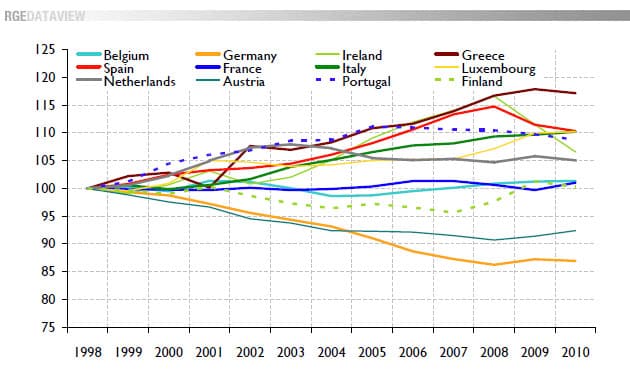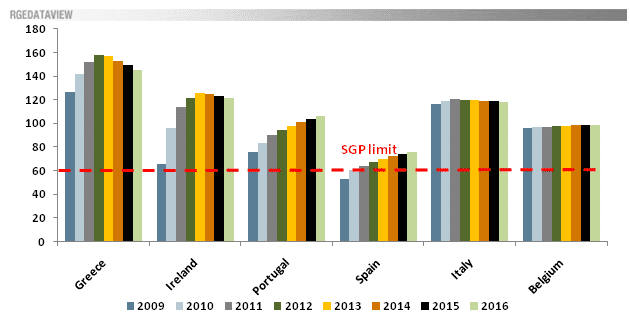The Eurozone Could Break Up Over a Five-Year Horizon
By Nouriel Roubini
- The current “muddle through” approach to the eurozone (EZ) crisis is not a stable disequilibrium; rather, it is an unstable disequilibrium.
- Either the member states move from this disequilibrium toward a broader fiscal, economic and political union that resolves the fundamental problems of divergence (both economic, fiscal and in terms of competitiveness) within the union…
- …or the system will move first toward disorderly debt workouts and eventually even break-up, with weaker members departing. Over a five-year horizon, the odds of a break-up are at least one-third.
The EMU Has Always Fallen Short…
The EMU has never fully satisfied the conditions for an optimal currency area: Synchronized economic activity and growth rates; a high level of labor and capital mobility; fiscal federalism allowing the fiscal risk-sharing of idiosyncratic national shocks; and a significant degree of political union.
The hope was that the EMU’s lack of independent monetary, fiscal (the Growth and Stability Pact fiscal constraints) and exchange rate policies would lead to the acceleration of structural reforms that would in turn lead to the convergence of productivity and growth rates, rather than increased divergence.
The reality turned out to be different… Paradoxically, the early interest rate convergence became damaging as it allowed a severe lack of fiscal discipline in some countries (such as Greece and Portugal) and the build-up of asset bubbles in others (such as Spain and Ireland). Moreover the lack of market discipline delayed the necessary structural reforms and led to divergences in wage growth relative to productivity growth, and thus a rise in unit labor costs in the periphery and a loss of competitiveness that led to economic divergence between the PIIGS and the core. And the straightjacket of common monetary and currency policy exacerbated the real growth divergence at a time when structural and fiscal policies diverged.
Figure 1: Divergent Unit Labor Costs (ULCs, relative to EZ average, 1998 = 100)
Note: ULCs are computed as the ratio between compensation per employee and real GDP per employed person
Source: European Commission
Any successful monetary union has eventually been associated with political and fiscal union. Political union in the EZ and EU has stalled and a backlash against anonymous Brussels bureaucrats imposing their views on nation states is brewing. The EU does not have a common foreign policy or a common defense policy; while economic and financial policy convergence has reached an impasse.
A fiscal union would require that a significant amount of federal/central revenues be mobilized for the provision of EU/EZ-wide public goods, but there is no mechanism or will to provide the EU with enough power to create a semi-federal system of taxation, transfers and spending. Fiscal risk-sharing also includes the sharing of losses from financial crises, which requires a central EU-based system of supervision and regulation of financial institutions rather than the current national approach. Losses would be shared throughout the EZ only if the responsibility for properly supervising and regulating financial institutions were at the central level.
Fiscal union would also require the widespread issuance of Eurobonds, where the taxes of German (and core) taxpayers backstop not only German debt but also the debt of the members of the periphery. But the German (and core) taxpayers would not accept that unless binding rules are established to ensure that periphery countries cannot again indulge in persistently and systematically large fiscal deficits; while periphery taxpayers would not accept the total loss of fiscal independence—fiscal slaves to the views of the core—that binding fiscal rules would require.
It is also clear that the heavy burden of private and public debt in a number of periphery countries—Greece, Ireland, Portugal—is so large that a debt restructuring and reduction will eventually have to occur, thus imposing—slowly or sharply—a capital loss on these periphery agents’ foreign creditors (mostly financial institutions in the core). This will exacerbate conflicts between the core and periphery as it will redistribute wealth from savers and creditors to debtor and borrowers.
Figure 2: General Gross Government Debt Projections (if fiscal adjustments go as planned, % of GDP)
Source: IMF, World Economic Outlook Database, April 2011
And while an orderly debt reduction may at least resolve the issue of excessive debt in some insolvent economies or financial systems, the restoration of economic convergence requires the restoration of competitiveness convergence. Without it, part of the periphery will stagnate or even contract for many years to come and eventually decide to exit the monetary union and return to a system of domestic national currencies.
So, How Can Competitiveness Be Restored and Growth Resume in the Periphery?
- One way would be for the euro to sharply fall in value toward—say—parity with the U.S. dollar. But with Germany being uber-competitive, the core running current-account surpluses and the ECB always more hawkish than the Fed, there is little chance that the euro would fall sharply enough to restore the competitiveness of the PIIGS.
- A second solution would be to take the German reform approach: Accelerate structural reforms to increase productivity growth and keep a lid on wage growth below productivity growth to reduce unit labor costs. But this will not work: Structural reforms show their gains only in the medium term—in the short run, they can actually reduce growth as you shed labor and capital from declining firms and sectors; also, it took 15 years for Germany to reduce unit labor costs by keeping wage growth below productivity growth; if Greece, Portugal, etc. start today, the benefit in terms of competitiveness and growth will occur only in a decade, too late to be politically acceptable.
- A third option is deflation: If the PIIGS could reduce prices and wages by 5% per year for five years, you would get the necessary cumulative compound fall of 30% in nominal prices/wages to restore competitiveness. The problem with the deflation route to a real depreciation is twofold. First, deflation is associated with persistent recession and no social or political body could accept another five years of recession to reduce prices/wages by 30%; Argentina tried the deflation route to a real depreciation, but after three years of an ever-deepening recession gave up and decided to default and exit its currency board peg. Second, even if by some miracle deflation was feasible and successful, the real value of the already-high private and public debts would rise sharply (a balance-sheet effect), forcing even-larger defaults and debt reductions. All the talk by the ECB and the EU of an “internal depreciation” is thus faulty: Even the often-heard argument that reducing public salaries would lead to a rapid real depreciation is erroneous as it would require private wages and prices to fall accordingly and would not prevent the damaging balance-sheet effects. The alleged case of a successful internal devaluation—that of Latvia—is not relevant here: Entering the crisis, its public debt was 9% of GDP, not the 100%-plus of Greece; losses from depression and deflation were taken by foreign banks dominating its banking system; and accepting a draconian 20% fall in output was politically feasible as Latvia did not want to fall into the arms of the Russian bear again. And let us not forget that the necessary fiscal austerity has—in the short run—a negative effect on economic growth; thus, it postpones the recovery of growth that is necessary to make the reforms and austerity socially and politically feasible; and that is also necessary to make the debt and deficit ratios sustainable (as falling GDP increases those ratios, despite fiscal austerity efforts).
If the euro is not going to fall sharply, if reducing unit labor cost takes too long to restore competitiveness and growth and if deflation is unfeasible or (if achieved) self-defeating, there is only one other way for the PIIGS to restore competitiveness and growth: Leave the monetary union, go back to national currencies and thus achieve a massive nominal and real depreciation. After all, in all emerging market financial crises where growth was restored, a move to flexible exchange rates was necessary and unavoidable on top of official liquidity, austerity and reform and, in some cases, debt restructuring and reduction.
Surely a Break-Up Remains Inconceivable? Not the Way We’re Going…
Of course, today, the idea of leaving the EZ sounds inconceivable, even in Athens and Lisbon. It is simply not on the table. And of course, the costs of exit would be significant: A country leaving the EZ might also be kicked out of the EU as there is no mechanism to exit EMU without exiting the EU. Also, exit would impose: 1) Trade losses on the rest of the EZ via massive real depreciation; and 2) massive capital losses on the creditor core as the sharp increase in the real value of euro debt once the new currency is sharply depreciated would either force a default on private and public euro debts, or a conversion of such euro debts into the new depreciated national currency (the equivalent of the Argentine pesification of dollar debts). The latter would be a not-so-disguised massive capital levy on the creditor core.
But scenarios that are inconceivable today might not be so far-fetched five years from now if some of the periphery economies stagnate or contract for the next five years, an outcome that is not unlikely if competitiveness is not restored, if the burden—debt overhang—of unsustainable private and public debts is not reduced and if there is little move toward more burden-sharing within the EZ via the progressive adoption of some form of a fiscal union. What has glued the EZ together has been the convergence of interest rates and low real rates sustaining growth, the hope that reforms will maintain convergence when a one size-fits-all monetary and exchange policy opposes growth and the prospect of a move toward a fiscal and political union. But now, the benefits of interest rate convergence are no longer there as: Bond vigilantes have woken up and periphery spreads will remain high for a long time; increasingly, a common monetary policy and currency is a size that does not fit all; while fiscal union, risk-sharing and political union don’t seem to be on the horizon.
So, it is not a matter of if or whether debt restructurings will occur, but rather when (sooner or later) and how (orderly or disorderly) they occur. And even debt reduction will not be sufficient to restore competitiveness and growth. So, unless the latter can be achieved in other ways, the option for PIIGS of exiting the monetary union will become dominant as the benefits of staying in will be lower than the benefits of exiting, however bumpy or disorderly that exit may end up being.
Messy marriages lead to messy divorces, but if the marriage doesn’t work, even the threat of a messy divorce cannot keep couples together that are not a long-term match.
Nouriel Roubini is the co-founder and chairman of Roubini Global Economics, an independent, global macroeconomic and market strategy research firm. The firm’s website, Roubini.com, has been named one of the best economics web resources by BusinessWeek, Forbes, the Wall Street Journal and the Economist. He is also a professor of economics at New York University’s Stern School of Business. Dr. Roubini has extensive policy experience as well as broad academic credentials.
The preceding content first appeared at Roubini.com and is reproduced here with the expressed consent of Roubini Global Economics, LLC. If you would like to reproduce the post, please contact Roubini Global Economics, LLC.


Comments are closed.